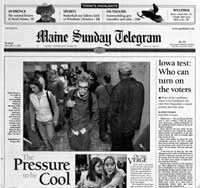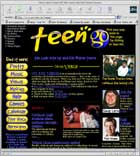Teens Go for “TeenGo” Web Site and Series
By Jessica Tomlinson
Community Coordinator
The Portland Newspapers
It all started months before Columbine. The Portland Press Herald wanted to do a project that would give Maine teens a voice while creating a unique collaboration between print and online media.
Then came the Colorado high school shooting that left 15 dead. “What is going on with our teens?” suddenly became the profound question of the year – not just for Maine but also for the nation.
To find the answers, reporter Barbara Walsh spent months interviewing hundreds of youths. Her series, “On the Verge,” launched in January, has provoked an outpouring of interest and involvement.
 “In order to write about teenagers I felt I had to absorb as much of their world as possible,” Walsh says. “‘Think of yourself as a cultural anthropologist,’ my editor, Jeannine Guttman told me.”
“In order to write about teenagers I felt I had to absorb as much of their world as possible,” Walsh says. “‘Think of yourself as a cultural anthropologist,’ my editor, Jeannine Guttman told me.”
“I hung out in their rooms, read the posters on their walls, rummaged through their music and book collections. Noted whether they wore peach or watermelon lip gloss. I cruised in their cars, hung out at dances and pep rallies. I tagged along with them to the mall, in school hallways, at Wendy’s. I asked them why they wore the preppy and hugely popular Abercrombie & Fitch clothing or why they outfitted themselves in baggy jeans and chains? Why they dyed their hair orange?
“I asked to see the contents of their backpacks, their pocketbooks, their computers. For the most part, these teens welcomed me into their world. They were often surprised and baffled that an adult actually valued what they had to say,” Walsh said.
“When I first began reporting for ‘On the Verge,’ I searched for kids on the edge, kids who had the most problems, the schools with the highest pregnancy rate. Then my editor explained, ‘No. We want ordinary kids experiencing daily, routine struggles.’ “
“Huh? At first, I didn’t get it. I’d always reported about the extremes, the circus freaks of society, the killers and rapists, the flaws in the courts and the prisons, the mistakes, the misery.”
“Now, I was being told to write about ordinary kids? Cut it out. Where’s the story?”
“After interviewing nearly a 100 kids, I found the story. I found the right five kids to tell me about their struggle to fit in, to feel OK about themselves despite their constant mood swings or overwhelming bouts of happiness or sadness,” she said.
“Or as one seventh grader put it: ‘Sometimes I think I’m going to have a break-down – like I can’t live. And the next minute, I’m just, like, happy.’ “
Through the lives of five young people – seventh-grade girls who never got invited to the popular parties, a student body president who reveled in pep rallies and prom nights, a poetic teenager with spiked orange hair and a loathing for all things mainstream, and a teenager who got harassed for being gay – Walsh found the elements of a great story. She wrote about their fears, their dreams, their thrills, their disappointments.
And it touched the lives of hundreds of readers – kids, parents, grandparents, teachers, single people. In these teens, readers saw themselves and their kids. Readers connected because these kids were mainstream rather than society’s aberrations. And because of those connections, the story became more meaningful.
“What’s fascinating about doing a public journalism project like this is that readers notice the difference. And they comment on that,” said editor Guttman. “They won’t use the nomenclature that we journalists use – they won’t use the words civic journalism or public journalism. But they will remark about how different the story felt to them. They’ll say it had more authenticity, more relevance. It really resonated with them and spoke to their lives.”
“Readers don’t know what we did as reporters and editors to make the story so different, but the fact is, the readers do see and do acknowledge these stories as distinct and unique from the rest of the journalism that appears in the newspaper. And they want more of these stories, not less.”
Michaela Rathbun McDonald, a 14-year old from Portland, wrote, “I think ‘On the Verge’ is a great idea. It can give adults, especially parents, a certain amount of insight into the daily lives of teenagers. I liked how many different groups of people were represented in the articles and that every story was without the writer’s opinions. Well done.”
The state was abuzz. One school plastered the gym with the series and encouraged students to share their thoughts on flip charts. Teachers used it as a catalyst for class discussion. Parents sat down with their kids for heart-to-heart talks.
Lucy Cressey, a mother of a 14-year old, shared her resolution. “My first priority from this point on is to make myself more available to my daughter to vent her pain, confusion and frustration. I also will be searching for ways to alleviate the pressures – how, I am not sure, but I feel as if my rose-colored glasses have been removed and the reality I am seeing is not pleasant.”
In designing the project, the newspaper wanted a place for many teens to share their views. Cyberspace was the obvious choice. With teens spending hours a day on the Internet, it has become a “third place,” where people naturally congregate. The Net offers unlimited space, the ability to share ideas instead of appearances (very important when dealing with teens) and immediacy.
 So, content appeared first on the web site – as photos, essays and forum postings. This content preceded Walsh’s stories by two months and served as an additional listening post for her.
So, content appeared first on the web site – as photos, essays and forum postings. This content preceded Walsh’s stories by two months and served as an additional listening post for her.
The web site, www.portland.com/teengo, features a photo gallery, essays on teen life, an interactive forum, the series’ first installment and reader feedback.
The photos, in particular, told a new and different story. With $6,000 in Pew Center funding, the newspaper purchased the cameras and hosted forums. Deering High School student John Clark described his experience with the project, “We don’t have much of a voice and, when we do, our words are shrugged off and not taken seriously. It was surprising to hear that a newspaper would take on the task of voicing students’ issues.”
TeenGo has received more than 100,000 hits. Not bad considering Maine’s population is only 1.3 million.
The next installment in late March covers the issue of teen dating, relationships and sex. Future stories will address such issues as families, the lure of money and technology and the pressure to succeed.
